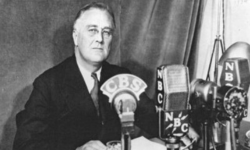Between the stock market crash of 1929 and the election of Franklin D. Roosevelt in 1932, the U.S. economy fell off a cliff. During that three-year period, five thousand banks failed and nine million bank accounts were suddenly worthless. In the calamity of the Great Depression, millions of people were thrown out of work, unemployment stood at 25%, and employment income dropped by half. Nearly 20% of non-farm mortgages were foreclosed. Hundreds of Hoovervilles of newly impoverished, newly homeless, newly desperate people sprang up across the country.
Roosevelt arrived in office with a raft of ideas to help the hurting, pull the U.S. out of its pickle, and, incidentally, prevent a revolution. He called it the ‘New Deal,’ which included regulation of banks and Wall Street, employment relief, benefits for agriculture, and other programs. The necessary pieces of the highly popular legislation quickly became law. The problem? The U.S. Supreme Court, which at the time was dominated by elderly Gilded Age justices hostile to anything that even remotely smelled of government regulation of business. The Court issued a series of decisions invalidating aspects of the New Deal.
Clearly, something had to be done.
After his landslide 1936 re-election, Roosevelt hit upon “court packing” – increasing the number of justices on the Court to dilute the power of the old (literally) guard. He introduced legislation to increase the number of justices. Although ultimately unsuccessful, the Roosevelt’s court packing attempt had its effect. One of the elderly justices retired. The swing vote on the Court started swinging the other way. The New Deal survived the court challenges.
Court packing was difficult for Roosevelt, but it’s much easier for the USPTO’s Patent Trial and Appeal Board (PTAB), which hears challenges to issued patents and appeals from patent denials.
A recent whistleblower case shows just how easy. The whistleblower was Michael Fitzpatrick, a PTAB Administrative Patent Judge. Mr. Fitzpatrick was part of a three-judge panel hearing a patent case. The panel heard the case, reached a decision and prepared an opinion, all in a timely manner. The panel then forwarded the opinion to PTAB management for review. After a delay, two top members of PTAB management added themselves as additional judges to the original panel with no notice to the parties to the patent case and ordered that the original opinion not be released. The original panel clearly took its obligations seriously. There followed a period of over two years during which the original panel demanded (in barely polite terms) that the new panel members get off their asses and either remove themselves from the case or come up with a decision. As it turns out, they did both. The new panel members eventually came up with an opinion and then removed themselves from the panel before the opinion issued, all without notice to the parties. Mr. Fitzpatrick added a concurring opinion revealing the changes to the panel by PTAB management and arguing that the ‘stacking’ of the panel was illegal. Management demanded that he remove the concurring opinion, which he did.
Mr. Fitzpatrick was removed from the case, effectively demoted and given a negative performance review, which was a precursor to firing him. USPTO Director Iancu (this occurred during the last administration) “voiced a desire to USPTO management to terminate Mr. Fitzpatrick.” Mr. Fitzpatrick pursued review of these retaliatory actions before the USPTO, to no avail.
Mr. Fitzpatrick, a Federal civil service employee, filed an appeal with the Merit System Protection Board. An administrative judge heard the appeal and issued a 99 page decision on May 28, 2023. The administrative judge concluded that panel stacking without notice to the parties was illegal, found in favor of Mr. Fitzpatrick, and ordered that he be restored to his former position. Mr. Fitzpatrick can now request attorneys’ fees (he was represented by Steptoe & Johnson) and damages.
This was not the first nor the last time that the PTAB manipulated panels of administrative patent judges to achieve a desired result. Panel ‘stacking’ is a common practice and likely illegal. The U.S. Solicitor General apologized to the Supreme Court for misleading it on this point in an earlier case. None of this attention means that the PTAB has changed its panel stacking practices.
The Merit System decision is the first instance of which this author is aware of a judicial or quasi-judicial decision addressing panel stacking at the PTAB. The USPTO can appeal the ruling, but may choose not to appeal to avoid a decision on the subject by an actual Federal judge.
The takeaway: Don’t believe for a minute that the PTAB is in any way independent. Despite the judicial trappings, it is an arm of USPTO management.
Robert Yarbrough, Esq.


